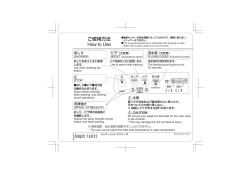
Technical Manual ES/iPS Differentiation Monitoring Kit - Human Endoderm
ES/iPS Differentiation Monitoring Kit - Human Endoderm Technical Manual General Information Kit Contents Storage Condition Required Equipment and Materials Precaution Preparation of Solutions The embryonic stem cells (ES cells) or induced pluripotent stem cells (iPS cells) are differentiated to various cells through the three germ layers: endoderm, mesoderm and ectoderm. One of the secretory proteins in a culture medium was found to be a marker of the conversion level of ES or iPS to endodermal cells. This secretory protein has a good correlation with Sox17 and Foxa2 which are commonly used proteins as markers of endoderm differentiation. Amount of this protein in the cell culture supernatant determined by ELISA, can be used to monitor the efficiency of differentiation of endodermal cells from ES/iPS cells. Since this kit is designed for 96-well microplate format, it is suitable for multiple sample measurements such as a screening with inducers of differentiation for ES/iPS cells. This product was developed by a collaborative work between Institute of Molecular Embryology and Genetics, Kumamoto University and Dojindo Laboratories. - Coated 96-well Strip Plate - Standard - Reagent A - Reagent B x1 x1 x1 x1 - Washing Buffer - Storage Buffer - Substrate Solution - Plate Seal x1 0.5 ml x 1 10 ml x 1 x3 o Store at 0-5 C. - Microplate reader - Single and multichannel pipettes - Paper towel - 1.5 ml tube - Sulfuric acid Centrifuge the tube briefly before opening the cap; contents may be attached on the wall or the cap of the tube. - Washing Buffer Dissolve the contents in the Washing Buffer packet with 1000 ml of deionized or distilled water. Store the Washing Buffer Solution at room temperature. - Stop Solution Prepare 0.2 mol/l sulfuric acid solution with deionized or distilled water. - Standard Stock Solution Add 20 μl of the Storage Buffer to the Standard tube (blue cap) and dissolve by gentle pipetting. o *After dissolution, store at -20 C and use within one month. - Reagent A Stock Solution Add 150 μl of the Storage Buffer to the Reagent A tube (red cap) and dissolve by gentle pipetting. o *After dissolution, store at -20 C and use within one month. - Reagent B Stock Solution Add 150 μl of the Storage Buffer to the Reagent B tube (green cap) and dissolve by gentle pipetting. o *After dissolution, store at -20 C and use within one month. General Protocol 1) Take the plate out from the bag, and remove all the strips from the frame (photo A). Standard Stock Solution 3 µl Washing Buffer 297 µl *Before opening the bag, bring back to the ambient temperature. 2) Remove necessary number of strips from the seal and put them back to the frame (photo B and C). Keep the remaining strips in the tightly closed bag and store in a refrigerator (photo D). *If a strip comes off from the seal, press the strip tightly against to the seal or use a new plate seal to cover the strips. 3) Dilute the Standard Stock Solution 100-fold with the Washing Buffer in a 1.5 ml tube to prepare a 1000 ng/ml of the Standard Solution. Prepare the following Standard Solutions by serial dilution using the Washing Buffer (Fig 1). *Standard Solutions: 500, 250, 125 and 0 ng/ml *Since the Standard Solution diluted with the Washing Buffer is not stable, prepare the necessary amount of Standard Solutions immediately before use. A B C 250 µl 250 µl 250 µl Washing Buffer 250 µl Washing Buffer 250 µl 1000 ng/ml Standard Washing Buffer 250 µl 500 ng/ml Standard 250 ng/ml Standard 125 ng/ml Standard Fig 1. Procedure of Standard Solution preparation (n=2) D ES01 : ES/iPS Differentiation Monitoring Kit - Human Endoderm Revised January 22, 2014 General Protocol 1 4) Add 100 μl Standard Solution or the samples (cell culture supernatant) to each well and incubate for 1 hour at room temperature. 2 3 4 A 0 ng/ml Standard Sample E B 125 ng/ml Standard Sample F C 250 ng/ml Standard Sample G 5) Dilute the Reagent A Stock Solution 100-fold with the Washing Buffer to prepare Reagent A working solution. D 500 ng/ml Standard Sample H E Sample A Sample I 6) Discard the solution, and wash the wells with 250 μl Washing Buffer three times. Tap the plate several times against paper towels to remove the buffer in each well. Add 100 μl Reagent A working solution to each well, then incubate for 1 hour at room temperature. F Sample B Sample J G Sample C Sample K H Sample D Sample L 1 *In the case of duplicate measurement, use two strips for four samples. By using multiple strips, more samples can be measured simultaneously (Fig 2). 2 *If the absorbance of samples is over the range, dilute the samples with the Washing Buffer. 7) Dilute the Reagent B Stock Solution 100-fold with the Washing Buffer to prepare Reagent B working solution. Fig 2.Example of Standard Solution and Sample arrangement (n=2) 8) Discard the solution, and wash the wells with 250 μl Washing Buffer three times. Tap the plate several times against paper towels to remove the buffer in each well. Add 100 μl Reagent B working solution to each well, then incubate for 30 minutes at room temperature. 9) Discard the solution, and wash the wells with 250 μl Washing Buffer five times. Tap the plate several times against paper towels. Add 100 μl Substrate Solution to each well, and incubate for 10-15 minutes at room temperature. 10) Add 100 μl Stop Solution to each well, and measure the absorbance at 450 nm by microplate reader. Calculate the amount of the marker protein in the samples using the calibration curve obtained from the Standard Solution. Usage Example - Monitoring endoderm differentiation derived from human iPS cells 5 Human iPS cells (253G1) were seeded to the concentration of 1.0 x 10 cell/well on a 96-well plate and cultured in a differentiation medium containing 100 ng/ml Activin A. The medium was changed in every 24 hours. The 100 μl of supernatant was analyzed by this ELISA kit to determine the amount of marker protein (Fig 3A). Meanwhile, the amount of differentiation to endodermal cells was evaluated by immunohistochemical analysis (Fig 3B). The marker Protein in the supernatant was found to correlated well with the ratio of endoderm differentiation. A B 90 Product Information SOX17+/FOXA2+ cells (%) Marker protein (ng/ml) 800 700 600 500 400 300 200 100 Related Product Information 70 60 50 40 30 20 10 0 0 D1 D2 D3 D4 D5 D1 D2 D3 D4 D5 Fig 3. The correlation of marker protein in supernatant with endodermal cells Notes 80 (A) The amount of marker protein (ng/ml) in the supernatant (B) The amount of endodermal cells expressed SOX17 and FOXA2 The amount of the marker protein may vary depending on the differentiation method or cell density. In order to determine the differentiation ratio by using this kit, please prepare the correlation graph with the ELISA data and immunostaining or flowcytometry data. H. Iwashita, N. Shiraki, D. Sakano, T. Ikegami, M. Shiga, K. Kume and S. Kume., PloS ONE., 2013, 8(5): e64291. Reference If you require an assistance, please contact Dojindo customer service. Dojindo Molecular Technologies, Inc. 30 West Gude Dr., Suite 260, Rockville, MD 20850, USA Toll free: 1-877-987-2667 Phone: 301-987-2667 Fax: 301-987-2687 E-mail: info@dojindo.com Web: www.dojindo.com ES01 : ES/iPS Differentiation Monitoring Kit - Human Endoderm
© Copyright 2025

















